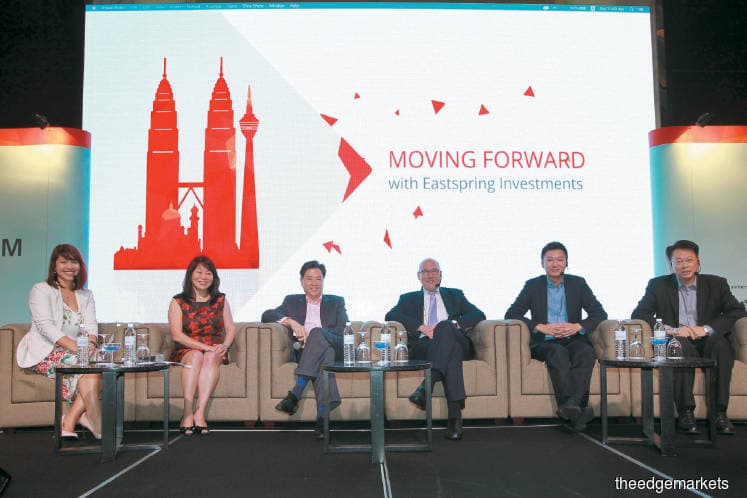
This article first appeared in The Edge Financial Daily on March 12, 2018
KUALA LUMPUR: Market bulls are expected to continue their charge, with the rising US inflation rate just a “tiny bear” that does not pose a big risk to the global markets as yet. Amidst all these, there are investment opportunities available, said speakers at the inaugural Eastspring Public Symposium 2018 titled “Crouching Bears, Charging Bulls” in Kuala Lumpur last Saturday.
Robert Rountree, global strategist at Eastspring Investment (Singapore) Ltd kicked off the forum with his session “Crouching Bears, Charging Bulls: Market Drivers in 2018”, saying that the rising US inflation rate does not pose a big risk yet because commodity prices remain relatively low and the US job market, while in full employment, might not see a strong rise in consumer spending and inflation moving forward.
“Many of these jobs created are for aged 65-years-old and above. The salary for these jobs are low and the people of this age group do not spend a lot. It’s [inflation risk] just a ‘tiny bear’.”
He said the global economy continues to expand while company earnings are on the rise.
“This is supported by ample market liquidity as central banks globally are still injecting money into the market, even though they are raising rates and tightening monetary policies,” he said.
Rountree pointed out that market mispricing presents investment opportunities for investors to bargain hunt. These opportunities exist within the Asian ex-Japan equity market.
Within the region, he said the infrastructure, healthcare and consumer goods sector are undervalued at the moment.
He also added that the China A-shares and Hong Kong H-shares are relatively cheap while the US and European equities are overpriced.
Ooi Boon Peng, chief investment officer of Eastspring Investments (Singapore) Ltd in charge of fixed income, in his session “Rising yields, rising income: 2018 fixed income outlook” also said that US inflation is expected to remain benign as wage growth is unlikely to see a sharp rise.
He said the majority of jobs created for the older age group is comparable to the situation in Japan, where it has an unemployment rate of below 2.5% and a wage growth of less than 0.5%.
In addition, Ooi said that the more widespread adoption of internet and technology and the emergence of new ones (such as blockchain, artificial intelligence and robotics) are other factors that cause the US inflation rate to remain low.
At the same time, Ooi said capital expenditure and consumer sentiments in many countries are on the rise, which shows that the global economy continues to recover.
He said opportunities for fixed income remain in the emerging markets (EM), where markets are volatile but provide good yields. “We are tactically overweight on Latin America, generally positive on Brazil’s local bonds. In Asia, we have been bullish on Indonesia and India’s fixed income performance. India is our main overweight due to the reforms that the country is currently undertaking.”
He added that India’s government has taken a lot of steps to become a more formal economy. These steps include demonetisation to curb black money, introducing the goods and services tax and financial inclusion programmes.
Chen Fan Fai, Eastspring Investment Bhd chief investment officer for retail and institutional business took the stage for the third session, titled “Diversification benefits of absolute return strategies”. He said investors who want to reduce volatility in their overall investment portfolio could allocate part of their money in absolute return funds.
Chen said these funds utilised different investment strategies and derivative products to reduce volatility in achieving targeted returns. These funds are also less correlated with market indexes as compared to most of the existing unit trust funds in the market.
“More than half of all unit trust funds have a correlation with the market of greater than 75%, whereas half of all absolute return strategies [funds] have a correlation with the market of less than 25%. It provides investors with diversification.”
Chen said while there are not many absolute return funds locally, he expected to see more being offered in the market if there is investor demand.
During the panel discussion where one of the topics was whether local investors have enough choices available in unit trust investments as compared to others in the region, Wong Weiyi, general manager of Fundsupermart Malaysia, said there are over 400 unit trust funds available in Malaysia.
“In comparison, Singapore has about 1,200 products while Hong Kong has about 1,800,” he said.
However, Wong said the local fixed deposit rates ranged from 3% to 4%, which is much higher than those in Singapore of about 1%. The higher rates would make fixed deposits a relatively ideal place for investors to park some of their money, while placing the rest of their money into existing unit trust funds in the market.
He said this is unlike Singapore, where investors would need a wider variety of unit trust funds to structure their investment portfolios to chase for higher returns. “As such, 400 over products should be able to cater to local demand. Nevertheless, there will be more products coming into the market in the future.”
On planning for retirement, Carol Yip, CEO of Aged-Care Group Sdn Bhd, said investors who are planning to stay in an aged care home should be disciplined in taking profits and set aside some cash for the future.
She said the amount of money one needed for an aged care home for five years is about RM250,000 at the current market price. Taking into account the effect of inflation, it could go up to RM500,000. “If you were to stay in a hotel-style aged-care facility, it’s easily a million. Set aside money for that. You need cash,” she said.